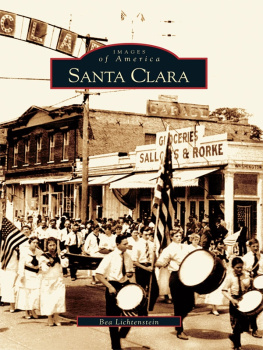For Sarah and Kit
Copyright 1989 by Marc Simmons
All Rights Reserved.
No part of this book may be reproduced in any form or by any electronic or mechanical means including information storage and retrieval systems, without permission in writing from the publisher, except by a reviewer who may quote brief passages in a review.
Library of Congress Cataloging in Publication Data:
Simmons, Marc.
Yesterday in Santa Fe.
Bibliography: p.
Includes index.
1. Santa Fe (N.M.)--History. I. Title.
F804.S245S56 1987 978.9'56 87-6449
ISBN: 0-86534-108-7
ISBN: 978-1611-39-2470 (e-book)
Published by
SUNSTONE PRESS
Post Office Box 2321
Santa Fe, NM 87504-2321 / USA
CONTENTS
PREFACE
"The best thing we derive from history," said Goethe, "is the enthusiasm it raises in us." Which is just another way of saying, history is to be enjoyed. And it is principally to this end that the following episodes have been written and are offered to all those who have some interest in Santa Fe as it used to be.
Many people believe that history is instructive, agreeing with Santayana's dictum that those who fail to learn from the past are condemned to repeat it. But the lessons of history are never self-evident; they remain open to a variety of interpretation and to misinterpretation. For example, to the earliest Anglo-American traders venturing over the Santa Fe Trail, New Mexico's captial appeared to be a shabby collection of mud huts clustered along narrow, dust-laden streets. And the population seemed timid and lacking in industry. Such observations filled the traders' chronicles and helped shape a negative stereotype that remained current for decades.
But a closer look and a less prejudiced assessment would have revealed to the Yankee merchants that an adobe building was well-suited to the place and the climate. Earth and straw for the bricks was plentiful. Abundant solar energy insured speedy drying and curing. And since no great skill was required either in the manufacture or laying up of bricks in the wall, the most humble family could possess a substantial dwelling. Moreover, a house of adobe was cool in summer and could be made warm in winter by feeding juniper and pion sticks to the corner fireplace.
Many skeptical Americans, in fact, were won over in the years that followed their arrival, finding that a mud house had its advantages as well as a measure of ingratiating charm.
They were also forced to revise their opinions of Santa Fe's native inhabitants. Hospitality came as natural to the New Mexicans as did their light-heartedness during a fiesta or fandango. With a limited technology, they nevertheless managed to feed themselves and provide some comforts in the household by careful utilization of available resources. And with primitive weapons they heroically defended themselves from marauding Indians.
Descendants of Santa Fe's pioneer citizenry still display these traits of friendliness, ingenuity, and endurance. And many of them, possessed of enterprise, have risen to positions of leadership in today's political, social, cultural, and business community.
Each of the little essays presented herein opens a small window on some aspect of life in New Mexico's ancient capital. Taken together, they form a kind of loose history covering a period of 350 years. The details of a number of these stories have long been familiar to historians but have not been available to a wider audience since they were tucked away in obscure corners. Several of the pieces offer wholly new information, representing original research on the part of the author. For the curious, a brief note at the end of the volume will explain the sources of the author's information.
For assistance in preparation of this book, thanks are extended to E.W. Tedlock, Jr., Dr. Myra Ellen Jenkins formerly of the New Mexico State Records Center and Archives, Dr. David Weber, Dr. John Kessell, Susie Henderson, and Frank Turley.
Marc Simmons
Los Cerrillos, New Mexico
YESTERDAY IN SANTA FE
Tewa Indians were probably the first people to inhabit the site of modern Santa Fe. Vestiges of their pueblos were evident until recent times, and even now excavations within the limits of the city produce archaeological proof of this earlier occupation. Fairly extensive ruins remain down the Santa Fe River near the community of Agua Fria, Pindi Pueblo on the north side of the stream being one of the larger sites. Indians from this area, no doubt farmed up river, using the arable flat lands now occupied by the city. They also must have had trails leading from their adobe villages along the length of the valley into the foothills of the Sangre de Cristo Mountains. We know very little about these original inhabitants, because when the Spaniards arrived in the sixteenth century, they found the banks of the Santa Fe River deserted.
Francisco Vasquez de Coronado, who made the earliest and most extensive reconaissance of New Mexico in the years 1540-1542, was once thought to have left a small group of followers behind, mostly Mexican Indians, who established an informal settlement on the Santa Fe location. After this story was proved a myth, the popular belief arose that Juan de Onate had been the true founder about the year 1608. Certainly Oate was a likely candidate for the honor, as he had been responsible for the formal colonization of New Mexico beginning in 1598. However, it is now known that that the only town he organized was the short-lived Villa of San Gabriel, situated near the Indian Pueblo of San Juan at the junction of the Chama River and the Rio Grande. Governor Pedro de Peralta, Oate's successor, was, in fact, the man who laid the foundations for Santa Fe early in 1610.
THE NAMING OF SANTA FE
A HISTORICAL PROBLEM
Santa Feans traditionally have been enthusiastic about joining in celebrations of all kinds: fiestas, historical anniversaries, jubilees, and religious holidays. At such events, which combine solemnity with merrymaking, the city's Hispanic heritage is reaffirmed and the people establish a personal link with their long and colorful past.
One of the most glittering and ambitious commemorative events ever staged in the old capital took place in the summer of 1883. The date 1550 had arbitrarily been agreed upon as the year of Santa Fe's founding (nothing was known at this time of the community's origin), which meant that as of 1883, she had reached the respectable age of 333 years or a third of millennium. Accordingly, elaborate plans were formulated for a "Tertio-Millenial" celebration.
One July 2 the festivities began and continued for six weeks. Beneath a sparkling sky, all citizens turned out in their finest raiment to view seemingly endless processions, parades, and historical pageants. The center of the celebration was located at present Federal Place, with the oval surrounding the grounds staked out as a race track. Here horse, mule and burro contests were run, and U.S. Cavalry units engaged in competitive drills and presented displays of fine horsemanship. For the more sanguinary spectator there were chicken pulls and cockfights. And in one splendid extravaganza, Coronado and his men fought a staged battle with rebellious Indians. Numerous Pueblo Indians, as well as members of other tribes, had been invited to participate in the commemorative activities, and in native dress they mingled in the streets with citizens arrayed as conquistadores, Spanish soldiers, mountain men, and cowboys.











